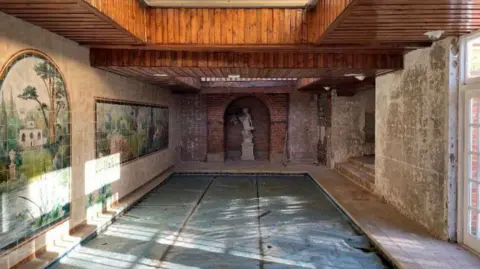Mansion left 'gutted' by works to be restored
 Harrow Council
Harrow CouncilA 17th Century Grade II listed building in north-west London is set to be restored to its former glory after works carried out by the owner left it "literally gutted".
Harrow Council's planning committee has approved plans for the complete restoration of The Rookery, a Georgian mansion house and stables in Stanmore.
It was originally built for the owner of the adjacent Clutterbuck Brewery – Lord Clutterbuck – and remained in the same family for several generations.
In recent years a series of "unlawful works" were carried out, the committee was told, including using décor described as "fake old" and removing original plaster from the walls, which had done "harm to the listed building".
A new owner of The Rookery took possession of the site in 2022. Listed Building Consent, required to make changes to a listed building, was not obtained before work began.
The refurbishment was halted by conservationists and enforcement in December that year, and has ceased ever since, according to the Local Democracy Reporting Service.
Consent has now been granted for internal and external alterations to take place, including a full interior "strip out" – much of which has already taken place – and renewal of the decoration.
The plans outline how the building will be restored to "match the historic details" and "recreate the historic features" where genuine, according to Harrow Council's planning officer.
 Harrow Council
Harrow CouncilThe Rookery was described as of particular historic and architectural importance due to its age and association with the brewery, as well as its traditional architectural features and historic fabric.
The planning officer said the restoration work would provide a "unique opportunity" to find out more information about the significance and historic development of the building as the modern surface fabric is removed.
Asked if the building could be restored to its original state, the planning officer said it was "the best proposal [in] the moment we are at".
 Harrow Council
Harrow CouncilNo enforcement action was served when the works were discovered because officers sought "to get a better understanding of what had happened", but prosecution was still be an option, according to the committee chair Marilyn Ashton.
She described the application as "a positive" in respect of moving things forward but called the building's current condition "a big disappointment" and that "accepting what's happened and being pragmatic doesn't make it all right".
"Having studied the report very clearly, one might infer that we have still got the option of prosecution because it is actually quite a serious problem to do this to a Grade II listed building. It isn't just one room or just a small feature, the whole place has literally been gutted."
She added there was "not much left of its historical value but hopefully we can put some of it back to make it look at least something like how it was".
Listen to the best of BBC Radio London on Sounds and follow BBC London on Facebook, X and Instagram. Send your story ideas to [email protected]
